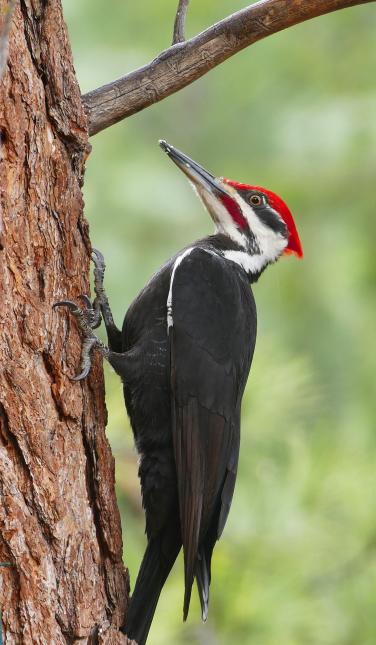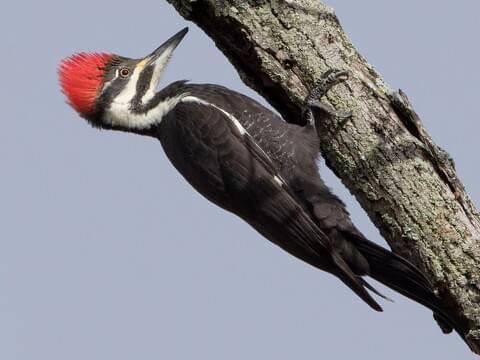Indigenous Woodpeckers in Florida: An Overview to Variety and Behaviors
Wiki Article
Discover the Fascinating Globe of Woodpeckers: Whatever You Required to Know
The globe of woodpeckers is a realm filled with one-of-a-kind habits, intricate adjustments, and a diverse selection of species. From their environments and circulation patterns to their feeding routines and specialized anatomical functions, woodpeckers have actually long mesmerized the rate of interest of ornithologists and nature enthusiasts alike.Woodpecker Habitats and Circulation
In North America, for example, woodpeckers can be detected in both coniferous and deciduous forests, using their solid beaks to forage for pests and create nesting cavities in trees. In Africa, particular woodpecker types have adapted to dry settings, such as the acacia woodlands, where they play an essential role in managing insect populaces.
Feeding Behaviors and Diet Plan
Amongst the numerous aspects of their actions, woodpeckers show distinct feeding behaviors and nutritional preferences. These birds are mainly insectivores, with a diet regimen that includes ants, beetles, caterpillars, and other pests located in trees. Woodpeckers use their solid beaks to pierce into the bark of trees, probing for insects and larvae concealed underneath the surface. Along with bugs, woodpeckers also take in nuts, seeds, fruits, and sap. Some varieties have specialized tongues with barbed suggestions that assist them extract pests from holes in wood.Woodpeckers are recognized for their drumming habits, which serves not only to connect with various other woodpeckers however additionally to locate food. The quick drumming audio is developed by the bird pecking on resonant surface areas like dead trees or metal poles. This behavior can draw in bugs hidden in the wood, allowing the woodpecker to detect their visibility and eat them.
One-of-a-kind Adjustments for Tree Climbing
In their proficient pursuit of pests concealed within tree bark, woodpeckers have actually developed amazing physiological functions that outfit them with unique adaptations for reliable tree climbing. One of the crucial adaptations is their zygodactyl feet, with 2 toes aiming forward and 2 directing backwards, offering a solid grasp on tree trunks. This customized foot arrangement enables woodpeckers to cling to upright surface areas easily, enabling them to go up and down trees with dexterity. In addition, woodpeckers have stiff tail feathers that act as a helpful prop while they climb up, helping in equilibrium and stability. Their strong, chisel-like beaks are not just made use of for exploration into timber yet additionally for clutching onto bark as they ascend tree trunks. Additionally, woodpeckers have solid neck muscle mass and a distinct head framework that soak up the effect of consistent pecking, permitting them to climb up vertically without causing injury to their brains. These adaptations showcase the incredible evolutionary style discover this that makes it possible for woodpeckers to browse trees with accuracy and efficiency.Diverse Woodpecker Variety Worldwide
With over 200 different varieties spread across different environments worldwide, the household of Picidae encompasses a remarkable diversity of woodpeckers. These birds can be discovered in forests, timberlands, savannas, and also metropolitan areas, showcasing their versatility to different environments. From the legendary Northern Flicker in North America to the vibrant and elusive Crimson-backed Flameback in Asia, each woodpecker types shows special qualities in terms of quill, behavior, and environment preference.Woodpeckers differ greatly in size, with the diminutive Downy Woodpecker measuring around 6-7 inches in length, while the effective Lineated Woodpecker can reach up to 17 inches - Woodpeckers in Florida. Their beaks also are available in various shapes and dimensions, mirroring their feeding habits. Some why not find out more types focus on removing pests from tree bark, like the Acorn Woodpecker, while others, such as the Black-cheeked Woodpecker, feed on fruits and seeds

Conservation Initiatives and Challenges
Preservation campaigns for woodpecker populaces are critical in alleviating the influence of habitat loss and other risks encountering these varied bird types. Woodpeckers deal with different obstacles to their survival, primarily because of logging, urbanization, climate modification, and invasive varieties. To attend to these issues, conservation initiatives focus on securing and restoring woodpecker this website habitats, implementing lasting forestry methods, and increasing awareness regarding the value of these birds in communities.One considerable obstacle in woodpecker preservation is the fragmentation of their environments, leading to separated populaces that are extra vulnerable to extinction - Woodpeckers in Florida. Conservationists work to produce wild animals corridors and protected locations that link these fragmented environments, enabling woodpeckers to relocate in between various areas for feeding, breeding, and shelter

Final Thought
To conclude, woodpeckers are remarkable birds with one-of-a-kind adaptations for tree climbing and feeding habits. They can be discovered in varied environments worldwide, encountering preservation obstacles as a result of habitat loss and human tasks. Recognizing their habitats, diet plans, and actions is essential for preservation efforts to protect these important bird species. More study and preservation actions are required to ensure the survival of woodpeckers in the wild.Report this wiki page